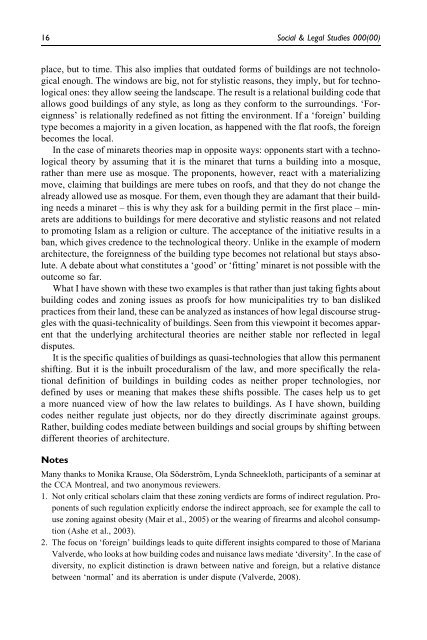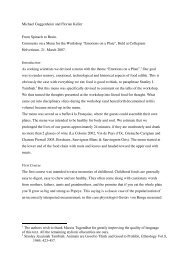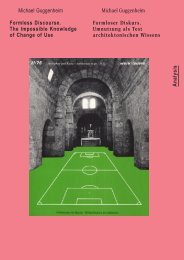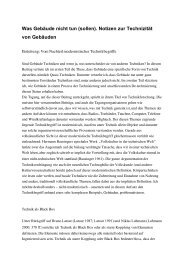The Laws of Foreign Buildings: Flat Roofs and Minarets - Michael ...
The Laws of Foreign Buildings: Flat Roofs and Minarets - Michael ...
The Laws of Foreign Buildings: Flat Roofs and Minarets - Michael ...
You also want an ePaper? Increase the reach of your titles
YUMPU automatically turns print PDFs into web optimized ePapers that Google loves.
16 Social & Legal Studies 000(00)<br />
place, but to time. This also implies that outdated forms <strong>of</strong> buildings are not technological<br />
enough. <strong>The</strong> windows are big, not for stylistic reasons, they imply, but for technological<br />
ones: they allow seeing the l<strong>and</strong>scape. <strong>The</strong> result is a relational building code that<br />
allows good buildings <strong>of</strong> any style, as long as they conform to the surroundings. ‘<strong>Foreign</strong>ness’<br />
is relationally redefined as not fitting the environment. If a ‘foreign’ building<br />
type becomes a majority in a given location, as happened with the flat ro<strong>of</strong>s, the foreign<br />
becomes the local.<br />
In the case <strong>of</strong> minarets theories map in opposite ways: opponents start with a technological<br />
theory by assuming that it is the minaret that turns a building into a mosque,<br />
rather than mere use as mosque. <strong>The</strong> proponents, however, react with a materializing<br />
move, claiming that buildings are mere tubes on ro<strong>of</strong>s, <strong>and</strong> that they do not change the<br />
already allowed use as mosque. For them, even though they are adamant that their building<br />
needs a minaret – this is why they ask for a building permit in the first place – minarets<br />
are additions to buildings for mere decorative <strong>and</strong> stylistic reasons <strong>and</strong> not related<br />
to promoting Islam as a religion or culture. <strong>The</strong> acceptance <strong>of</strong> the initiative results in a<br />
ban, which gives credence to the technological theory. Unlike in the example <strong>of</strong> modern<br />
architecture, the foreignness <strong>of</strong> the building type becomes not relational but stays absolute.<br />
A debate about what constitutes a ‘good’ or ‘fitting’ minaret is not possible with the<br />
outcome so far.<br />
What I have shown with these two examples is that rather than just taking fights about<br />
building codes <strong>and</strong> zoning issues as pro<strong>of</strong>s for how municipalities try to ban disliked<br />
practices from their l<strong>and</strong>, these can be analyzed as instances <strong>of</strong> how legal discourse struggles<br />
with the quasi-technicality <strong>of</strong> buildings. Seen from this viewpoint it becomes apparent<br />
that the underlying architectural theories are neither stable nor reflected in legal<br />
disputes.<br />
It is the specific qualities <strong>of</strong> buildings as quasi-technologies that allow this permanent<br />
shifting. But it is the inbuilt proceduralism <strong>of</strong> the law, <strong>and</strong> more specifically the relational<br />
definition <strong>of</strong> buildings in building codes as neither proper technologies, nor<br />
defined by uses or meaning that makes these shifts possible. <strong>The</strong> cases help us to get<br />
a more nuanced view <strong>of</strong> how the law relates to buildings. As I have shown, building<br />
codes neither regulate just objects, nor do they directly discriminate against groups.<br />
Rather, building codes mediate between buildings <strong>and</strong> social groups by shifting between<br />
different theories <strong>of</strong> architecture.<br />
Notes<br />
Many thanks to Monika Krause, Ola Söderström, Lynda Schneekloth, participants <strong>of</strong> a seminar at<br />
the CCA Montreal, <strong>and</strong> two anonymous reviewers.<br />
1. Not only critical scholars claim that these zoning verdicts are forms <strong>of</strong> indirect regulation. Proponents<br />
<strong>of</strong> such regulation explicitly endorse the indirect approach, see for example the call to<br />
use zoning against obesity (Mair et al., 2005) or the wearing <strong>of</strong> firearms <strong>and</strong> alcohol consumption<br />
(Ashe et al., 2003).<br />
2. <strong>The</strong> focus on ‘foreign’ buildings leads to quite different insights compared to those <strong>of</strong> Mariana<br />
Valverde, who looks at how building codes <strong>and</strong> nuisance laws mediate ‘diversity’. In the case <strong>of</strong><br />
diversity, no explicit distinction is drawn between native <strong>and</strong> foreign, but a relative distance<br />
between ‘normal’ <strong>and</strong> its aberration is under dispute (Valverde, 2008).<br />
16







